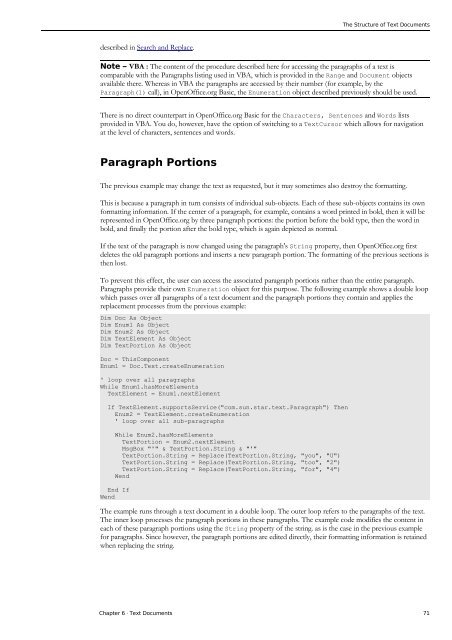OpenOffice.org BASIC Guide - OpenOffice.org wiki
OpenOffice.org BASIC Guide - OpenOffice.org wiki
OpenOffice.org BASIC Guide - OpenOffice.org wiki
You also want an ePaper? Increase the reach of your titles
YUMPU automatically turns print PDFs into web optimized ePapers that Google loves.
described in Search and Replace.<br />
The Structure of Text Documents<br />
Note – VBA : The content of the procedure described here for accessing the paragraphs of a text is<br />
comparable with the Paragraphs listing used in VBA, which is provided in the Range and Document objects<br />
available there. Whereas in VBA the paragraphs are accessed by their number (for example, by the<br />
Paragraph(1) call), in <strong>OpenOffice</strong>.<strong>org</strong> Basic, the Enumeration object described previously should be used.<br />
There is no direct counterpart in <strong>OpenOffice</strong>.<strong>org</strong> Basic for the Characters, Sentences and Words lists<br />
provided in VBA. You do, however, have the option of switching to a TextCursor which allows for navigation<br />
at the level of characters, sentences and words.<br />
Paragraph Portions<br />
The previous example may change the text as requested, but it may sometimes also destroy the formatting.<br />
This is because a paragraph in turn consists of individual sub-objects. Each of these sub-objects contains its own<br />
formatting information. If the center of a paragraph, for example, contains a word printed in bold, then it will be<br />
represented in <strong>OpenOffice</strong>.<strong>org</strong> by three paragraph portions: the portion before the bold type, then the word in<br />
bold, and finally the portion after the bold type, which is again depicted as normal.<br />
If the text of the paragraph is now changed using the paragraph's String property, then <strong>OpenOffice</strong>.<strong>org</strong> first<br />
deletes the old paragraph portions and inserts a new paragraph portion. The formatting of the previous sections is<br />
then lost.<br />
To prevent this effect, the user can access the associated paragraph portions rather than the entire paragraph.<br />
Paragraphs provide their own Enumeration object for this purpose. The following example shows a double loop<br />
which passes over all paragraphs of a text document and the paragraph portions they contain and applies the<br />
replacement processes from the previous example:<br />
Dim Doc As Object<br />
Dim Enum1 As Object<br />
Dim Enum2 As Object<br />
Dim TextElement As Object<br />
Dim TextPortion As Object<br />
Doc = ThisComponent<br />
Enum1 = Doc.Text.createEnumeration<br />
' loop over all paragraphs<br />
While Enum1.hasMoreElements<br />
TextElement = Enum1.nextElement<br />
If TextElement.supportsService("com.sun.star.text.Paragraph") Then<br />
Enum2 = TextElement.createEnumeration<br />
' loop over all sub-paragraphs<br />
While Enum2.hasMoreElements<br />
TextPortion = Enum2.nextElement<br />
MsgBox "'" & TextPortion.String & "'"<br />
TextPortion.String = Replace(TextPortion.String, "you", "U")<br />
TextPortion.String = Replace(TextPortion.String, "too", "2")<br />
TextPortion.String = Replace(TextPortion.String, "for", "4")<br />
Wend<br />
End If<br />
Wend<br />
The example runs through a text document in a double loop. The outer loop refers to the paragraphs of the text.<br />
The inner loop processes the paragraph portions in these paragraphs. The example code modifies the content in<br />
each of these paragraph portions using the String property of the string. as is the case in the previous example<br />
for paragraphs. Since however, the paragraph portions are edited directly, their formatting information is retained<br />
when replacing the string.<br />
Chapter 6 · Text Documents 71
















